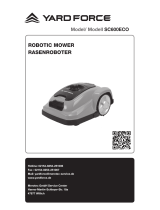• It is not permitted to modify the original design of
the product. All modifications are made at your
own risk.
• Check that there are no foreign objects such as
stones, branches, tools or toys on the lawn. If the
blades hit foreign objects the blades can be
damaged. Always switch off the product with the
ON/OFF button before clearing a blockage. Inspect
the product for damage before staring the product
again.
• If the product starts to vibrate abnormally. Always
switch off the product with the main switch or
ON/OFF button and inspect for damage before
staring the product again.
• Start the product according to the instructions.
When the product is switched on, make sure to
keep your hands and feet away from the rotating
blades. Never put your hands and feet under the
product.
• Never touch moving hazardous parts, such as the
blade disc, before it has come to a complete stop.
• Never lift up the product or carry it around when it
is switched on.
• Do not let persons who do not know how the
product works and behaves use it.
• The product must never be allowed to collide with
persons or other living creatures. If a person or
other living creature comes in the product’s way it
shall be stopped immediately. Refer to
To stop the
product on page 31
.
• Do not put anything on top of the product or its
charging station.
• Do not allow the product to be used with a
defective guard, blade disc or body. Neither should
it be used with defective blades, screws, nuts or
cables. Never connect a damaged cable, or touch
a damaged cable before it is disconnected from
the supply.
• Do not use the product if the ON/OFF button and
STOP button does not work.
• Always switch off the product using the ON/OFF
button when the product is not in use. The product
can only start when the product has been switched
on with the ON/OFF button and the correct PIN
code has been entered.
• GARDENA does not guarantee full compatibility
between the product and other types of wireless
systems such as remote controls, radio
transmitters, hearing loops, underground electric
animal fencing or similar.
• Metal objects in the ground (for example reinforced
concrete or anti-mole nets) can result in a
stoppage. The metal objects can cause
interference with the loop signal which then can
lead to a stoppage.
• Operation and storage temperature is 0-50 °C /
32-122 °F. Temperature range for charging is 0-45
°C / 32-113 °F. Too high temperatures might cause
damage to the product.
2.3.2 Battery safety
WARNING: Lithium-ion batteries can
explode or cause fire if disassembled, short-
circuited, exposed to water, fire, or high
temperatures. Handle carefully, do not
dismantle, open the battery or use any type
of electrical/mechanical abuse. Avoid
storage in direct sunlight.
For more information about the battery, refer to
Battery
on page 35
2.3.3 How to lift and move the product
WARNING: The product must be
switched off before lifting it. The product is
disabled when the indicator lamp on the
keypad is not lit.
CAUTION: Do not lift the product when
it is parked in the charging station. It can
damage the charging station and/or the
product. Push STOP and pull the product
out of the charging station before lifting it.
To safely move from or within the work area:
1. Push the STOP button to stop the product.
2. Push the ON/OFF button for 3 seconds and make
sure the product is switched off. Check that the
indicator lamp on the keypad is not lit. This means
12
- Safety 1298 - 007 - 16.09.2020





















